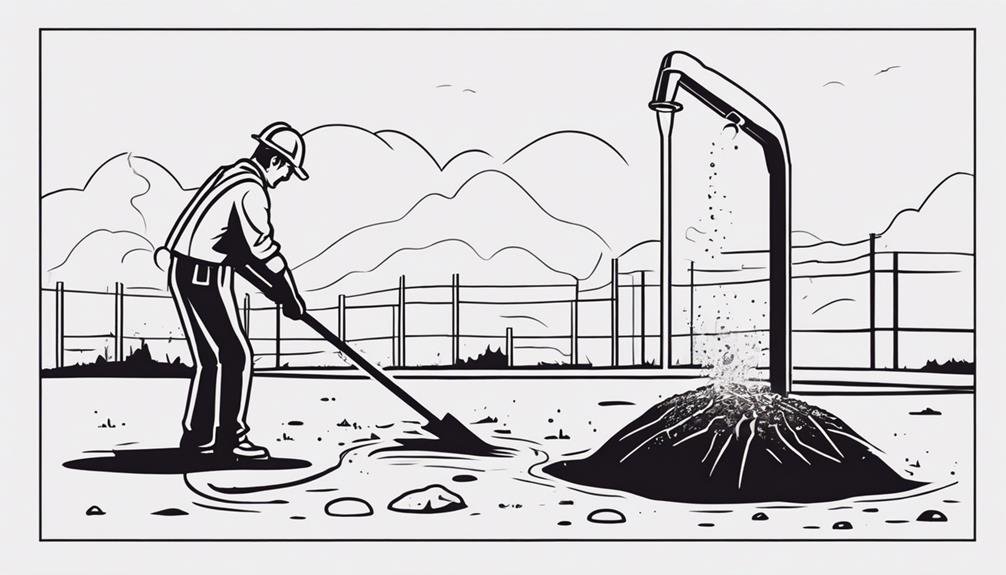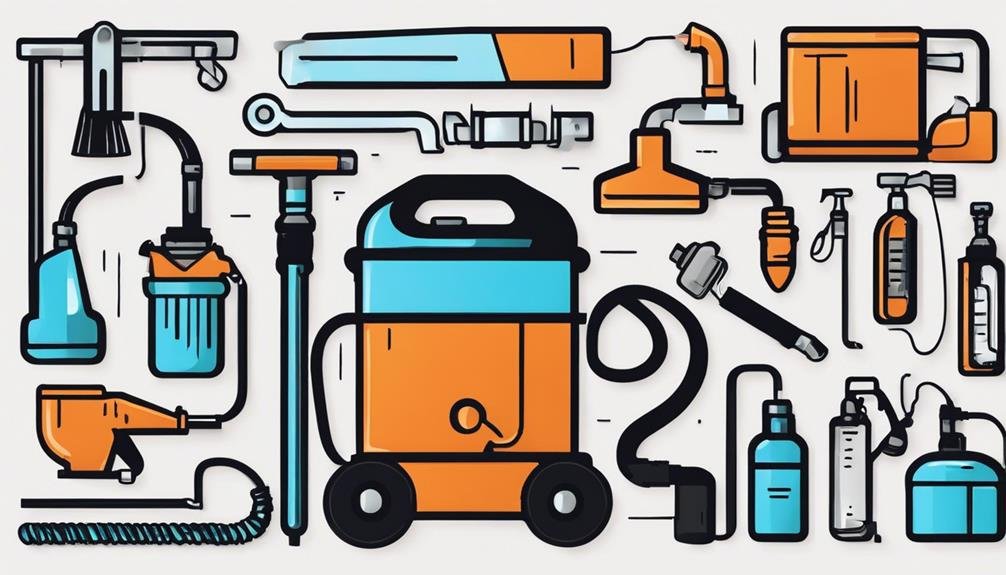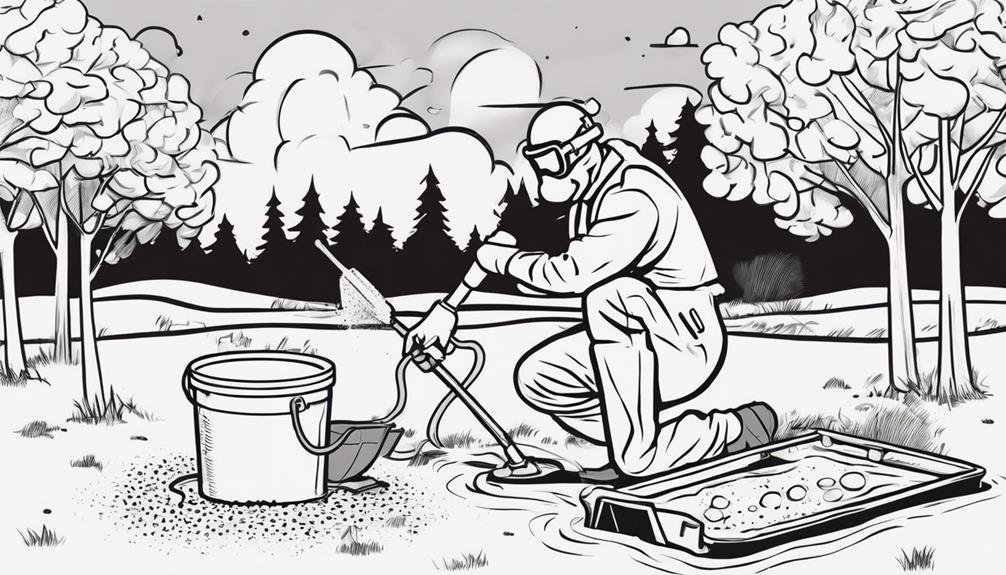When it comes to maintaining your septic tank, think of your tools as the keys to a well-functioning system – each one unlocking a different aspect of maintenance.
From essential digging tools that help you navigate underground to inspection and pumping equipment that ensures everything is in working order, your arsenal plays a crucial role.
But what about those unseen elements that keep your septic tank operating smoothly?
Stay tuned to discover the comprehensive list of ultimate tools designed to make DIY septic tank maintenance a breeze.
Key Takeaways
- Use digging tools like shovels and pickaxes for excavation tasks.
- Employ inspection equipment for monitoring tank conditions and maintenance needs.
- Utilize drain cleaning tools and treatments to prevent issues.
- Apply septic tank treatment supplies for efficient waste breakdown and odor control.
Essential Digging Tools

When conducting DIY septic tank maintenance, you'll require essential digging tools to effectively access and work on the system. Before digging, it's crucial to conduct soil testing to determine the composition and percolation rates of the soil surrounding your septic tank area. This information is vital in understanding how well the soil can absorb and filter wastewater.
To begin, a sturdy shovel is indispensable for digging and uncovering the septic tank lid. A square-point shovel is ideal for breaking through compacted soil and removing debris around the tank. A digging bar or a post-hole digger can help in loosening hard-packed soil and breaking through roots that may be obstructing access to the tank.
Additionally, a mattock or pickaxe is useful for breaking up tough soil and rocks that might impede your progress. A spade can aid in creating clean edges around the excavation site, ensuring a precise and well-defined work area. These digging tools are essential for efficiently accessing your septic tank for maintenance tasks.
Inspection and Pumping Equipment
To properly inspect and maintain your septic tank, you'll need specialized equipment for both inspection and pumping tasks. For DIY septic tank maintenance, inspection cameras are essential tools. These cameras allow you to visually assess the condition of your tank and identify any potential issues such as clogs, leaks, or cracks in the system. By using inspection cameras, you can proactively address problems before they escalate, saving you time and money in the long run.
When it comes to pumping equipment, soil analysis tools are crucial for determining the level of sludge and scum in your septic tank. By analyzing the soil around your tank, you can assess whether it's time to pump out the accumulated solids. This information helps prevent overflows and ensures the proper functioning of your septic system. Investing in soil analysis tools will enable you to maintain a healthy balance in your septic tank and avoid costly repairs down the line.
Drain Cleaning Tools

Invest in high-quality drain cleaning tools to effectively maintain and optimize the performance of your septic system. When it comes to maintaining your septic system, having the right tools for drain cleaning is crucial. One essential tool is a pipe snake, which helps clear clogs and blockages in your pipes. Whether it's hair, grease, or other debris causing the obstruction, a pipe snake can efficiently remove it, preventing backups and costly repairs.
Another important aspect of drain cleaning is root removal. Tree roots can infiltrate your pipes, causing damage and blockages. Investing in root removal tools can help you address this issue before it becomes a major problem. By regularly using these tools, you can keep your drains clear and your septic system functioning optimally.
In addition to mechanical tools, consider using enzyme treatments to maintain healthy bacteria levels in your septic system. These treatments can help break down organic matter and prevent odors. For optimal results, combine drain cleaning tools with enzyme treatments for a comprehensive septic system maintenance routine.
Septic Tank Treatment Supplies
For effective maintenance of your septic tank, ensuring you have the necessary septic tank treatment supplies is essential. Proper treatment supplies help in promoting the growth of beneficial septic tank bacteria and controlling unpleasant odors. Here are three vital supplies you should consider having:
- Septic Tank Bacteria Additive: This additive introduces beneficial bacteria into your septic system, aiding in the breakdown of solid waste and preventing clogs. It helps in maintaining a healthy balance of bacteria in your tank for optimal functioning.
- Odor Control Tablets: Odor control tablets are designed to eliminate foul smells that may emanate from your septic tank. These tablets contain ingredients that neutralize odors, keeping your surroundings fresh and pleasant.
- Septic Tank Cleaner: A septic tank cleaner helps in efficiently breaking down grease, oils, and other organic matter in your tank. Regular use of a quality cleaner can prevent buildup and keep your septic system running smoothly, reducing the risk of blockages and backups.
Safety Gear and Protective Equipment

Ensuring your safety during septic tank maintenance requires the use of appropriate safety gear and protective equipment. When working on your septic system, safety precautions are crucial.
Always wear protective gear such as gloves, goggles, and a mask to shield yourself from harmful fumes and bacteria present in the tank. Proper ventilation is key to preventing exposure to toxic gases like methane, which can be fatal in high concentrations.
Make sure to work in well-ventilated areas or use a portable ventilator to maintain a safe environment while inspecting or cleaning your septic tank. Additionally, sturdy boots with non-slip soles are essential to prevent falls on wet or slippery surfaces around the tank.
Frequently Asked Questions
How Often Should a Septic Tank Be Pumped?
You should pump your septic tank every 3-5 years, depending on the tank's capacity and household size. Regular pumping prevents solids from clogging the system, ensuring proper functioning. Consider professional inspections to determine the ideal frequency.
Can DIY Septic Tank Maintenance Cause Damage to the System?
Tinkering with your septic system might seem empowering, but DIY septic tank maintenance can backfire. Neglecting professional guidance or making simple errors could lead to costly damage. Avoid common mistakes to keep your system running smoothly.
Are There Any Environmentally-Friendly Septic Tank Treatment Options?
When maintaining your septic tank, consider eco-friendly alternatives for treatment. DIY solutions can include using enzymes, bacteria additives, or oxygen-based treatments. These options help break down waste naturally, supporting a healthy system and the environment.
What Are the Signs That a Septic Tank May Be in Need of Repair or Replacement?
When your septic system shows signs of distress like foul odors, slow drains, or soggy areas in the yard, it may need repair. Ignoring warning signals could lead to costly replacement, so act promptly.
How Can I Prevent Clogs and Backups in My Septic System?
To prevent clogs and backups in your septic system, utilize septic tank additives regularly and perform grease trap maintenance as recommended. These steps help break down waste, control odors, and prevent blockages, ensuring optimal functioning of your system.
Conclusion
In conclusion, armed with the ultimate tools for DIY septic tank maintenance, you can confidently tackle any issues that may arise.
With essential digging tools, inspection and pumping equipment, drain cleaning tools, septic tank treatment supplies, and safety gear in hand, you're well-equipped to keep your septic system running smoothly.
Remember, proper maintenance is key to avoiding costly repairs down the road. Stay proactive and prepared with the right tools at your disposal.

